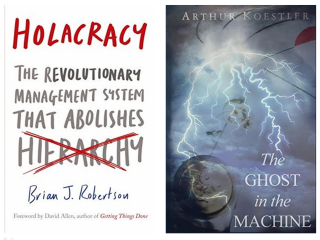
The organizational structure in Holacracy is a holarchy, a term coined by Arthur Koestler in The Ghost in the Machine. Brian Robertson writes in his book on Holacracy that:
The type of structure used for organizations in Holacracy is not a traditional hierarchy, but a “holarchy.” Arthur Koestler coined the term in his 1967 book The Ghost in the Machine. He defined a “holon” as “a whole that is a part of a larger whole” and a “holarchy” as “the connection between holons.” 1
Arthur Koestler actually defined a holon as a node in a hierarchic tree which behaves partly as wholes or wholly as parts, and a holarchy as a hierarchy of holons. Koestler writes that:
… to talk of sub-wholes (or sub-assemblies, sub-tructures, sub-skills, subsystems) is awkward and tedious. It seems preferable to coin a new term to designate these nodes on the hierarchic tree which behave partly as wholes or wholly as parts, according to the way you look at them. The term I would propose is ‘holon’, from the Greek holos = whole, with the suffix on which, as in proton or neutron, suggests a particle or part. 2
… we may say that the organism in its structural and functional aspects is a hierarchy of self-regulating holons which function (a) as autonomous wholes in supra-ordination to their parts, (b) as dependent parts in sub-ordination to controls on higher levels, (c) in co-ordination with their local environment. Such a hierarchy of holons should rightly be called a holarchy …3
In Holacracy, people act as sensors for the organization, processing tensions. Brian Robertson writes that:
An organization … is equipped with sensors — … the human beings who energize its roles and sense reality on its behalf.4
Organizations running with Holacracy are first and foremost purpose-driven … with all activities ultimately being for the sake of realizing the organization’s broader purpose. Every member then becomes a sensor for that purpose, and the rules of Holacracy’s governance process ensure that no individual interest can dominate.5
The organization is depending on you, as its sensor, to give voice to the tensions you sense so that it can evolve.6
Holacracy is focused on the organization and its purpose — not on the people and their desires and needs …7
What’s interesting is that Arthur Koestler not only coined the word holarchy, but also criticized the mechanistic view of organisms. Koestler called it a monumental superstition:
[The doctrine] … that all organisms, including man, are essentially passive automata controlled by the environment, whose sole purpose in life is the reduction of tensions …8
To paraphrase Arthur Koestler, it’s a monumental mistake to view people essentially as sensors controlled by the organization, whose sole purpose is to process tensions.9,10
Notes:
1 Brian Robertson, Holacracy: The Revolutionary Management System that Abolishes Hierarchy, (Penguin, 2015), p. 38.
2 Arthur Koestler, The Ghost in the Machine, (Last Century Media, 1982, first published 1967), p. 48.
3 Ibid., p. 103.
4 Brian Robertson, Holacracy: The Revolutionary Management System that Abolishes Hierarchy, (Penguin, 2015), p. 4.
5 Ibid., p. 166.
6 Ibid., p. 194.
7 Ibid., p. 198.
8 Arthur Koestler, The Ghost in the Machine, (Last Century Media, 1982, first published 1967), p. 3.
9 People also have the responsibility to act as role fillers in Holacracy. This is a sacred duty. See Brian Robertson, Holacracy: The Revolutionary Management System that Abolishes Hierarchy, (Penguin, 2015), p. 85. Role and soul are separated. Ibid., p. 42–46. People energize the roles and enact its accountabilities. Ibid., pp. 43, 97. And the organization depends on people processing its tensions. Ibid., pp. 7, 113, 125, 194, 200.
10 Arthur Koestler introduced the concepts of holarchy and holon in search for an alternative to the robot image of people. See Arthur Koestler, The Ghost in the Machine, (Last Century Media, 1982, first published 1967), p. 348.
Update 2016-07-26:
References 9 & 10 added.
Update 2018-01-26:
Formatting changed (tables changed to blockquotes).
Update 2022-09-15:
Text converted to blocks.
Leave a Reply
You must be logged in to post a comment.